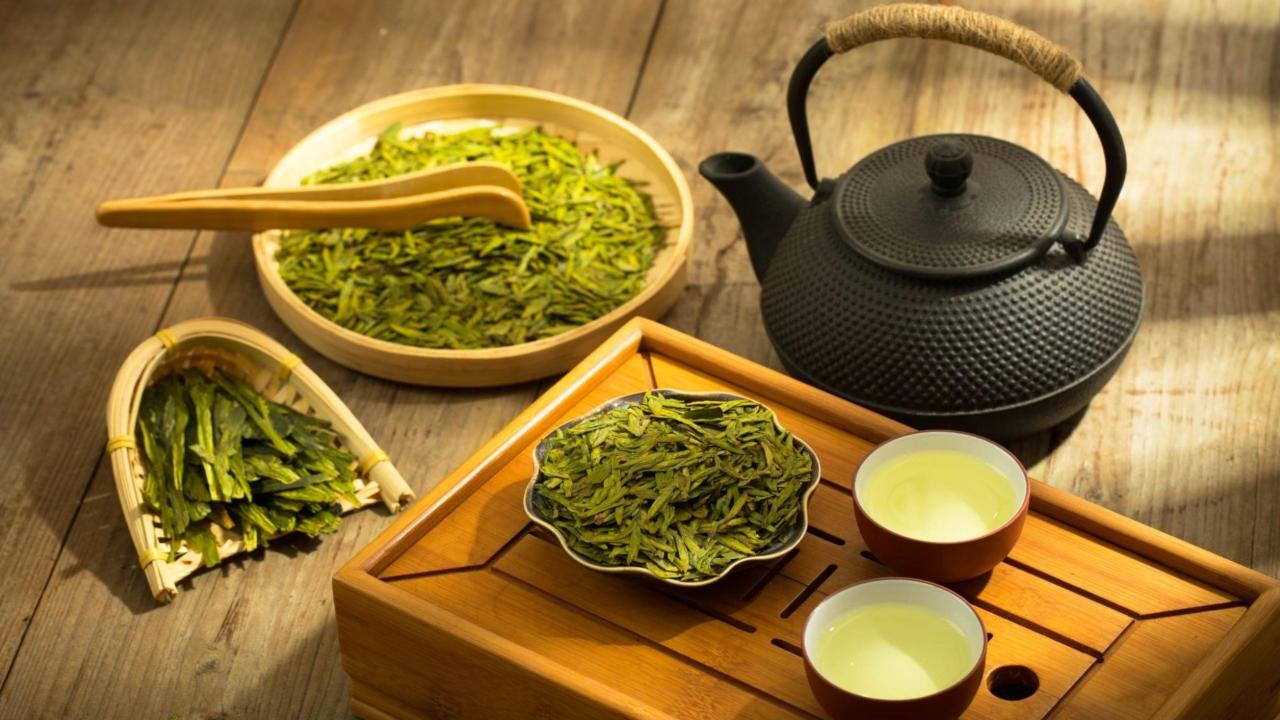Green Tea: Its Health Benefits and Potential Side Effects
Green tea is a type of tea made from the leaves of the Camellia sinensis plant. Unlike black or oolong tea, green tea is minimally processed and is not fermented, which helps to preserve its natural antioxidants and polyphenols. The leaves are quickly steamed or pan-fired to prevent oxidation, which maintains their green color and fresh, grassy flavor.
Green tea is known for its distinctive taste and is often enjoyed for its potential health benefits. It’s been consumed for centuries, particularly in East Asia, where it has a long history of use in traditional medicine and cultural practices.
Importance of Green Tea in Daily Life
Green tea has gained widespread popularity not just for its taste, but also for its potential health benefits. It is often touted for its rich antioxidant content, particularly catechins, which can help combat oxidative stress and inflammation.
Some studies suggest that regular consumption of green tea may contribute to improved cardiovascular health, enhanced brain function, and weight management.
In daily life, incorporating green tea can be a simple way to add a healthy habit to your routine. Whether enjoyed in a calming ritual or as a refreshing beverage throughout the day, green tea can offer a moment of relaxation and potentially support overall well-being.
Additionally, its low caffeine content compared to coffee makes it a good choice for those looking to reduce their caffeine intake without sacrificing their enjoyment of a warm, comforting drink.
Types of Green Tea
Green tea, with its delicate flavors and numerous health benefits, comes in a variety of types, each with unique characteristics, below are a few of them.
1. Sencha
Sencha is the most popular type of green tea in Japan. It is made from young leaves and buds that are steamed, rolled, and dried. This process helps preserve the vibrant green color and fresh flavor. Sencha has a slightly sweet, grassy taste with a mild astringency. It is enjoyed for its balanced flavor and is commonly served in Japanese households and restaurants.
Characteristics:
- Flavor: Fresh, grassy, and slightly sweet with a hint of astringency.
- Color: Bright green infusion.
- Processing: Steamed, rolled, and dried.
2. Matcha
Matcha is a powdered green tea made from specially grown and processed tea leaves. The leaves are shade-grown before harvest, which increases chlorophyll content and creates a rich, vibrant green powder. Matcha is whisked into hot water, creating a frothy, emerald-green tea with a strong, vegetal flavor and creamy texture.
Characteristics:
- Flavor: Rich, creamy, and umami with a pronounced vegetal taste.
- Color: Deep green infusion.
- Processing: Shade-grown, steamed, dried, and ground into a fine powder.
3. Gyokuro
Gyokuro is a premium Japanese green tea known for its delicate, sweet flavor and rich umami taste. The tea bushes are shaded for several weeks before harvesting, which enhances the amino acid content and reduces bitterness. Gyokuro leaves are steamed, rolled, and dried to preserve their delicate flavor and high nutrient content.
Characteristics:
- Flavor: Sweet, umami-rich, and smooth with a mild astringency.
- Color: Pale green infusion.
- Processing: Shade-grown, steamed, rolled, and dried.
4. Bancha
Bancha is a lower-grade green tea made from mature leaves harvested later in the season, often after the main harvest for Sencha. It has a more robust and slightly astringent flavor compared to Sencha. Bancha is typically less expensive and is consumed as a daily tea in many Japanese households.
Characteristics:
- Flavor: Earthy, robust, and slightly astringent.
- Color: Yellow-green infusion.
- Processing: Steamed, rolled, and dried.
5. Hojicha
Hojicha is a roasted green tea made from leaves that are roasted at high temperatures. This process imparts a toasty, nutty flavor and reduces the tea’s bitterness and astringency. Hojicha is typically enjoyed for its smooth, caramel-like taste and is often served in the evening due to its lower caffeine content.
Characteristics:
- Flavor: Nutty, toasty, and smooth with a caramel-like quality.
- Color: Reddish-brown infusion.
- Processing: Roasted at high temperatures.
6. Genmaicha
Genmaicha is a unique green tea blend that combines Sencha or Bancha with roasted brown rice. The rice adds a nutty, slightly sweet flavor and creates a distinctive aroma. Genmaicha is often referred to as “popcorn tea” due to the occasional popped rice grains in the blend. It is a comforting, flavorful tea enjoyed for its rich, toasty notes.
Characteristics:
- Flavor: Nutty, toasty, and slightly sweet with a rich aroma.
- Color: Light brownish-green infusion.
- Processing: Blend of green tea leaves and roasted brown rice.
The Health Benefits of Green Tea
Green tea is renowned for its wide range of health benefits, including improved metabolism and cardiovascular support. Discover how this ancient beverage can contribute to overall well-being.
1. Rich in Antioxidants
Green tea is rich in polyphenols, particularly catechins like epigallocatechin gallate (EGCG). These powerful antioxidants help neutralize free radicals in the body, reducing oxidative stress and preventing cellular damage.
By mitigating oxidative damage, these antioxidants play a role in reducing the risk of chronic diseases and bolstering the immune system.
2. Boosts Metabolism
The combination of caffeine and catechins in green tea enhances metabolic rate and fat oxidation. Caffeine stimulates thermogenesis, which increases energy expenditure.
While catechins boost fat oxidation and increase calorie burning. This synergy helps improve metabolic function and can contribute to overall energy expenditure.
3. Enhances Brain Function
Green tea contains both caffeine and L-theanine. Caffeine is a stimulant that increases alertness and cognitive function, while L-theanine promotes relaxation without drowsiness.
Together, they improve brain function, enhance focus, and stabilize mood by modulating neurotransmitter activity and promoting a balanced state of alertness and calm.
4. Supports Weight Loss
The caffeine and catechins in green tea can enhance metabolic rate and fat oxidation, which may aid in weight loss management.
By increasing the rate at which the body burns calories and promotes fat loss, green tea can be a supportive element in a weight loss regimen. Its ability to boost metabolism can help individuals manage and reduce body fat.
5. Reduces Risk of Cardiovascular Disease
Green tea contains antioxidants like catechins and flavonoids that help lower LDL cholesterol and triglycerides while improving arterial function.
These compounds reduce inflammation and oxidative stress in the cardiovascular system, which helps in maintaining healthy blood vessels and reducing the risk of heart disease and stroke.
6. Improves Dental Health
Catechins in green tea have antimicrobial and anti-inflammatory properties that reduce the growth of bacteria and viruses in the mouth.
These compounds can help reduce plaque formation, inhibit bacterial growth, and support oral hygiene. By minimizing bacterial load and inflammation, green tea contributes to better dental health and fresher breath.
7. Aids in Cancer Prevention
The polyphenols in green tea, especially EGCG, possess antioxidant properties that protect cells from DNA damage and inhibit the growth of cancer cells.
These compounds can help neutralize free radicals and reduce oxidative stress, which may lower the risk of developing certain types of cancer by preventing cellular damage and mutation.
8. Lowers Risk of Type 2 Diabetes
Green tea’s polyphenols, including catechins and EGCG, improve insulin sensitivity and regulate blood sugar levels. By enhancing the body’s response to insulin and helping maintain stable blood glucose levels, green tea can contribute to the prevention and management of type 2 diabetes.
9. Promotes Healthy Skin
The antioxidants and anti-inflammatory compounds in green tea, such as catechins and EGCG, help protect the skin from oxidative stress and inflammation.
These properties can reduce acne, soothe irritated skin, and protect against sun damage. Green tea extracts are often used in skincare products to promote a clear complexion and healthy skin.
10. Enhances Longevity
Regular consumption of green tea is associated with antioxidants and anti-inflammatory compounds that reduce the risk of age-related diseases.
The presence of catechins, flavonoids, and other bioactive compounds can help protect cells from damage and support overall health, contributing to a longer, healthier lifespan. The cumulative effects of these benefits may lead to improved overall health and longevity.
What is Matcha? : A Special Type of Green Tea
Matcha is a distinctive type of green tea that is ground into a fine powder. Unlike traditional green tea, where leaves are steeped and then discarded, matcha involves consuming the whole tea leaf in powdered form.
The process of making matcha begins with shade-growing the tea leaves to boost chlorophyll and amino acid content, which enhances its flavor and nutritional value.
After harvesting, the leaves are steamed, dried, and ground into a vibrant green powder. Matcha has a rich, creamy texture and a unique, complex flavor profile.
It is traditionally whisked with hot water to create a frothy, emerald-green tea, but it is also used in a variety of culinary applications, from lattes and smoothies to baking and cooking.
Benefits of Matcha Tea
1. Rich in Antioxidants: Matcha is loaded with antioxidants, particularly catechins like epigallocatechin gallate (EGCG). These antioxidants help combat oxidative stress and protect cells from damage, potentially reducing the risk of chronic diseases.
2. Boosts Energy and Focus: The caffeine in matcha provides a more sustained energy boost compared to coffee, thanks to its combination with L-theanine. This amino acid promotes a state of calm and improves focus and concentration, making matcha an excellent choice for mental clarity and sustained energy.
3. Enhances Metabolism: Matcha can help boost metabolism and increase fat oxidation. The combination of caffeine and catechins in matcha enhances thermogenesis, which supports calorie burning and weight management.
4. Supports Immune Health: Matcha’s high antioxidant content, including vitamins A and C, supports immune function. The catechins in matcha have antimicrobial properties that help protect against infections and strengthen the immune system.
5. Promotes Calm and Relaxation: The L-theanine in matcha has calming effects that help reduce stress and promote relaxation. This compound can counterbalance the stimulating effects of caffeine, providing a more balanced and serene experience.
6. Supports Detoxification: The high chlorophyll content in matcha helps detoxify the body by aiding in the removal of toxins and heavy metals. Chlorophyll also supports liver function and overall detoxification processes.
7. Enhances Skin Health: The antioxidants and anti-inflammatory compounds in matcha can help protect the skin from damage and reduce signs of aging. Matcha is often used in skincare products for its soothing and rejuvenating properties.
How to Prepare Matcha
1. Gather Your Tools: You will need high-quality matcha powder, a bowl (chawan), a bamboo whisk (chasen), a bamboo scoop (chashaku), and hot water (not boiling, ideally around 175°F or 80°C).
2. Sift the Matcha: To avoid clumps, sift 1-2 teaspoons (about 2-4 grams) of matcha powder into the bowl. Sifting ensures a smooth and consistent texture.
3. Add Hot Water: Pour about 2-3 ounces (60-90 milliliters) of hot water over the sifted matcha powder in the bowl. The water should be hot but not boiling, as boiling water can make matcha taste bitter.
4. Whisk the Matcha: Using the bamboo whisk, gently whisk the matcha and water in a zigzag motion (not a circular one) until it becomes frothy with a fine foam. Whisking helps dissolve the powder completely and creates a smooth, creamy texture.
5. Enjoy: Once the matcha is well-mixed and frothy, it is ready to drink. Enjoy your matcha immediately for the best flavor and maximum health benefits.
Optional: Matcha can also be used in lattes, smoothies, and various recipes. To make a matcha latte, simply mix the prepared matcha with steamed milk or a milk alternative for a creamy, caffeinated treat.
Side Effects of Green Tea
Potential Side Effects, While green tea is generally considered safe and beneficial for most people, it can have potential side effects, especially when consumed in excess:
1. Caffeine Sensitivity: Green tea contains caffeine, though less than coffee. For those sensitive to caffeine, even this lower amount can cause symptoms like jitteriness, insomnia, or palpitations.
2. Gastrointestinal Issues: Some individuals may experience stomach upset, nausea, or acid reflux after drinking green tea, particularly on an empty stomach. This can be due to its acidity and caffeine content.
3. Iron Absorption: Green tea can inhibit the absorption of non-heme iron (the type found in plant-based foods). This is particularly relevant for individuals with iron deficiency or those relying on plant sources of iron.
4. Headaches: Excessive consumption of green tea may lead to headaches in some individuals, likely due to its caffeine content or its effect on blood pressure.
Who Should Avoid Green Tea?
1. Pregnant and Breastfeeding Women: Pregnant and breastfeeding women should be cautious with green tea consumption due to its caffeine content. High caffeine intake during pregnancy has been linked to potential complications, and excessive caffeine can affect breastfeeding. It is generally recommended to limit caffeine intake during these periods.
2. Individuals with Iron Deficiency: Those with iron deficiency or anemia should limit their intake of green tea, especially around meals, as it may interfere with the absorption of iron from plant-based sources.
3. People with Gastrointestinal Conditions: Individuals with gastrointestinal conditions such as ulcers, acid reflux, or irritable bowel syndrome (IBS) may need to avoid green tea or limit their intake, as it can exacerbate symptoms due to its acidity and caffeine content.
4. Individuals with Heart Conditions: People with certain heart conditions, particularly those sensitive to stimulants, should be cautious with green tea due to its caffeine content. It’s important to consult with a healthcare provider if you have concerns about how green tea might affect your heart health.
Interaction with Medications
1. Anticoagulants and Antiplatelet Drugs: Green tea contains vitamin K, which can affect blood clotting. If you are on anticoagulant or antiplatelet medications (such as warfarin or aspirin), consult with a healthcare provider as green tea might interfere with these medications’ effectiveness.
2. Certain Antidepressants and Anxiety Medications: The caffeine and L-theanine in green tea can interact with some antidepressants and anxiety medications, potentially affecting their efficacy or causing side effects. It’s important to discuss green tea consumption with your healthcare provider if you are on these medications.
3. Blood Pressure Medications: Green tea can have a mild stimulating effect, which might affect blood pressure. If you are taking medications for blood pressure, monitor your response to green tea and consult with your doctor to ensure there are no adverse effects.
4. Thyroid Medications: The caffeine and compounds in green tea can affect thyroid function and interact with thyroid medications. Those with thyroid conditions or who are on thyroid medication should consult their healthcare provider before consuming green tea regularly.
5. Iron Supplements: If you take iron supplements, avoid drinking green tea around the time of taking them, as it can reduce the absorption of iron. It is advisable to space out the consumption of green tea and iron supplements by at least 1-2 hours.
As with any dietary change, it’s important to consult with a healthcare provider, especially if you have underlying health conditions or are taking medications.
FAQs
1. What is the best time to drink green tea?
Answer: Morning or early afternoon is ideal. Avoid drinking it on an empty stomach or late in the evening to prevent gastrointestinal discomfort and sleep disturbances.
2. Can pregnant women drink green tea?
Answer: Yes, but limit intake to 2-3 cups daily due to caffeine content. Excessive consumption may affect iron absorption and overall pregnancy health.
3. How much green tea should I drink daily?
Answer: 2-3 cups daily is generally recommended. This amount provides health benefits without excessive caffeine. Adjust based on individual tolerance and health goals.
4. Does green tea help in reducing belly fat?
Answer: Green tea may support belly fat reduction due to its metabolism-boosting properties. It’s most effective when combined with a balanced diet and regular exercise.
5. What are the differences between green tea and black tea?
Answer: Green tea is less oxidized, resulting in a lighter flavor and lower caffeine. Black tea is fully oxidized, giving it a richer flavor and higher caffeine content.
6. Can green tea cause any side effects?
Answer: Yes, potential side effects include caffeine-related issues like jitteriness and insomnia, gastrointestinal discomfort, and reduced iron absorption. Moderation is important.
7. Is green tea safe for children?
Answer: Green tea can be safe in small amounts but should be limited due to its caffeine content. Consult a pediatrician before offering it to children.
8. Can green tea interact with medications?
Answer: Yes, green tea can interact with anticoagulants, blood pressure medications, and thyroid medications. Consult your healthcare provider if you are on any medications.
9. How should green tea be stored?
Answer: Store green tea in an airtight container, away from light, heat, and moisture to preserve its freshness and flavor.
10. Can green tea be consumed cold?
Answer: Yes, green tea can be enjoyed cold. Brew it, then chill it in the refrigerator, and serve over ice for a refreshing beverage.
Green tea offers numerous health benefits, from boosting metabolism to improving brain function. By incorporating green tea into your daily routine, you can enjoy its many benefits while staying mindful of its potential side effects.
Resources:
- Beneficial Properties of Green Tea Catechins(1)
- Effect of green tea consumption on blood lipids: a systematic review and meta-analysis of randomized controlled trials(2)
- Green tea consumption and the risk of stroke: A systematic review and meta-analysis of cohort (3)
- Effect of green tea on glucose control and insulin sensitivity: a meta-analysis of 17 randomized controlled trials(4)
- Serum Ethylamine Levels as an Indicator of l-Theanine Consumption and the Risk of Type 2 Diabetes in a General Japanese Population: The Hisayama Study(5)

























